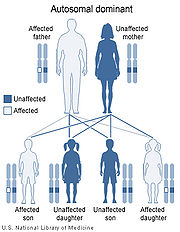
Monilethrix
Encyclopedia
Monilethrix is a rare autosomal
dominant hair
disease that results in short, fragile, broken hair that appears beaded. It comes from the Latin word for necklace
(monile) and the Greek word for hair (thrix).
. Individuals vary in severity of symptoms. Nail deformities may also be present as well as hair follicle
keratosis
and follicular hyperkeratosis
.
 Monilethrix is caused by mutations affecting the genes KRTHB1 (KRT81
Monilethrix is caused by mutations affecting the genes KRTHB1 (KRT81
), KRTHB3 (KRT83
), or KRTHB6 (KRT86
) which code for type II hair cortex
keratins. The disorder is inherited in an autosomal dominant manner. This means that the defective gene(s) responsible for a disorder is located on an autosome
, and only one copy of the gene is sufficient to cause the disorder, when inherited from a parent who has the disorder.
Autosome
An autosome is a chromosome that is not a sex chromosome, or allosome; that is to say, there is an equal number of copies of the chromosome in males and females. For example, in humans, there are 22 pairs of autosomes. In addition to autosomes, there are sex chromosomes, to be specific: X and Y...
dominant hair
Hair
Hair is a filamentous biomaterial, that grows from follicles found in the dermis. Found exclusively in mammals, hair is one of the defining characteristics of the mammalian class....
disease that results in short, fragile, broken hair that appears beaded. It comes from the Latin word for necklace
Necklace
A necklace is an article of jewellery which is worn around the neck. Necklaces are frequently formed from a metal jewellery chain. Others are woven or manufactured from cloth using string or twine....
(monile) and the Greek word for hair (thrix).
Characteristics
The presentation may be of alopeciaAlopecia
Alopecia means loss of hair from the head or body. Alopecia can mean baldness, a term generally reserved for pattern alopecia or androgenic alopecia. Compulsive pulling of hair can also produce hair loss. Hairstyling routines such as tight ponytails or braids may induce Traction alopecia. Both...
. Individuals vary in severity of symptoms. Nail deformities may also be present as well as hair follicle
Hair follicle
A hair follicle is a skin organ that produces hair. Hair production occurs in phases, including a growth phase , and cessation phase , and a rest phase . Stem cells are principally responsible for the production of hair....
keratosis
Keratosis
Keratosis is a growth of keratin on the skin. More specifically, it can refer to:* actinic keratosis * hydrocarbon keratosis* keratosis pilaris , also known as * seborrheic keratosis-See also:...
and follicular hyperkeratosis
Hyperkeratosis
Hyperkeratosis is thickening of the stratum corneum, often associated with a qualitative abnormality of the keratin, and also usually accompanied by an increase also in the granular layer...
.
Cause and Genetics

KRT81
Keratin, type II cuticular Hb1 is a protein that in humans is encoded by the KRT81 gene.-Further reading:...
), KRTHB3 (KRT83
KRT83
Keratin 83, also known as KRT83, is a protein which humans is encoded by the KRT83 gene.- Function :The protein encoded by this gene is a member of the keratin gene family. As a type II hair keratin, it is a basic protein which heterodimerizes with type I keratins to form hair and nails...
), or KRTHB6 (KRT86
KRT86
Keratin, type II cuticular Hb6 is a protein that in humans is encoded by the KRT86 gene.-Further reading:...
) which code for type II hair cortex
Type II hair keratin
Type II hair keratin is one of the two types of hair keratin. It is a basic protein which heterodimerizes with type I hair keratins to form hair and nails....
keratins. The disorder is inherited in an autosomal dominant manner. This means that the defective gene(s) responsible for a disorder is located on an autosome
Autosome
An autosome is a chromosome that is not a sex chromosome, or allosome; that is to say, there is an equal number of copies of the chromosome in males and females. For example, in humans, there are 22 pairs of autosomes. In addition to autosomes, there are sex chromosomes, to be specific: X and Y...
, and only one copy of the gene is sufficient to cause the disorder, when inherited from a parent who has the disorder.

